Navigating the New LinkedIn Landscape: Key Changes Impact Employers & Job Seekers

LinkedIn, the go-to platform for professional networking, is set to roll out significant changes in 2024 that promise to reshape the way employers hire and job seekers promote themselves. Understanding these updates is crucial for maintaining a competitive edge in the dynamic world of employment. Let’s delve into the two major shifts – alterations to LinkedIn Jobs and modifications to Public Profiles – and explore their potential implications.
LinkedIn Jobs: A Shift in Models
In 2023, LinkedIn revolutionized job postings for employers with a new model. This approach allowed for unlimited “basic job” postings given a minimum investment in a “promoted jobs” bucket. This was a departure from the traditional model of paying for a set number of job slots. The new system featured two types of postings:
- Promoted Jobs: Here, employers define their target audience and budget, and LinkedIn boosts these jobs in search results, adhering to a pay-per-click (PPC) model.
- Basic Jobs: These posts maintain the appearance of promoted jobs but lack targeted audience pushing and appear in search results only after promoted jobs.
However, this system posed challenges. Large organizations struggled with managing the distinction between promoted and basic roles, often limited by the number of admins and the complexity of budget allocation. Smaller employers, while benefiting from unlimited postings, faced dilemmas in job promotion investment.
Due to these complexities, LinkedIn is reverting to the job slot model. This shift will likely reduce the number of jobs on the platform, affecting both employers and job seekers.
LinkedIn Public Profiles: Restricting Visibility
Public profiles on LinkedIn are undergoing significant changes, particularly in how information is displayed to non-logged-in users. This update includes:
- Headlines: No longer visible.
- Summary: Only the first line and 88 characters will be shown.
- Experience & Education: Limited to the most recent entries, with other details hidden.
- Licenses, Certifications, Volunteer Experience, Honors & Awards: Partial visibility maintained.
These changes will notably impact talent sourcing. Techniques like LinkedIn X-rays and Google PSEs/CSEs will face limitations, with search engines like Google and Bing already showing reduced results. This also diminishes the SEO optimization of profiles, necessitating a strategic approach to the visible 88 characters.
Furthermore, LinkedIn aims to curtail the use of public data by people aggregators and AI tools, pushing for the adoption of premium licenses, particularly the Recruiter platform. This indicates a significant strategy shift, focusing on enhanced insights for premium users.
Additional LinkedIn Updates to Watch
Beyond these major changes, LinkedIn is introducing other notable features:
- Build a Resume: Now located under ‘More,’ facilitating easy resume creation.
- Visit My Website: A new ‘Visit my website’ button for personal profiles.
- Hashtags Depreciation: There are ongoing changes, with the extent still unclear, but hashtag depreciation is underway.
- Profile Verification: To authenticate real individuals, a key feature in the era of AI and deepfakes.
- ‘Open To’ Providing Services: A boon for consultants, though recruitment is conspicuously absent.
- Enhanced Post Analytics: For Premium subscribers, you can now see who has viewed your profile following your post.
- Collaborative Articles: A new approach to take to boost personal SEO.
- Dropping of X/Twitter: LinkedIn has dropped X from the list of partners.
- Skills: The option to showcase up to 100 skills.
Conclusion: Adapt to Change
The 2024 updates to LinkedIn bring both challenges and opportunities. Whether you’re hiring or seeking opportunities, staying informed and adapting to these changes is essential. By understanding and leveraging these new features, you can stay ahead in the ever-evolving professional landscape.
Sources:
- LinkedIn X-Ray is soon to be dead | Sourcing Training by Klikwork
- LinkedIn Profiles Redacted, X-Ray Dying, Aggregators Will Suffer | Boolean Strings by Irina Shamaeva
- The Adventures of X-Ray Are Mysterious | Boolean Strings by Irina Shamaeva
- Is LinkedIn X-Ray Search No Longer Working? | Full Stack Recruiter by Jan Tegze
- NEW LinkedIn Feature(s) Captured in the Wild in 2024 | Keep Rocking LinkedIn!
- Hashtag Depreciation | LinkedInformed
